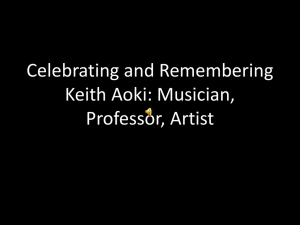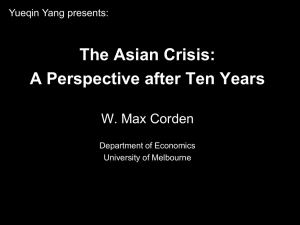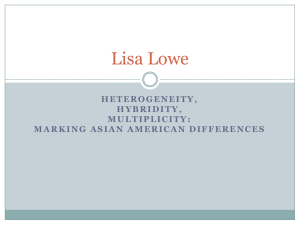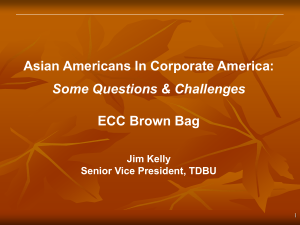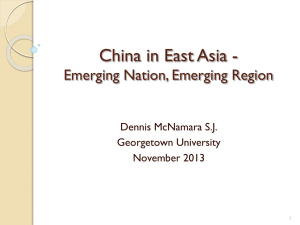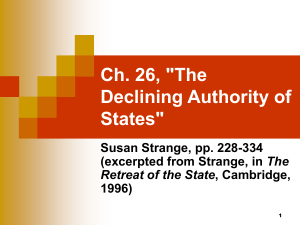Breaking the Bamboo Ceiling: Assets for Advancement in College
advertisement
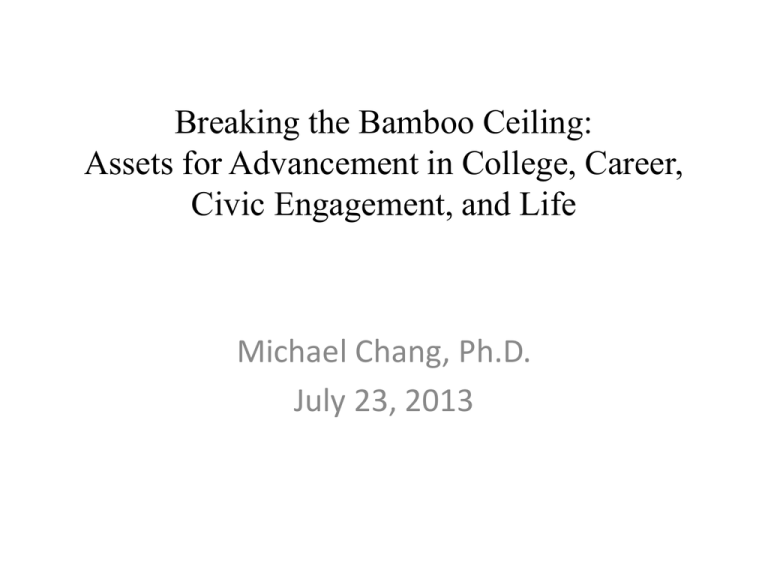
Breaking the Bamboo Ceiling: Assets for Advancement in College, Career, Civic Engagement, and Life Michael Chang, Ph.D. July 23, 2013 What is a “bamboo ceiling”? The term "bamboo ceiling" was coined in writer Jane Hyun's book, Breaking the Bamboo Ceiling: Career Strategies for Asians.[1] It is defined as a combination of individual, cultural, and organizational factors that impede Asian Americans’ career progress inside organizations. Since then, a variety of sectors (including nonprofits, universities, the government) have discussed the impact of the ceiling as it relates to Asians and the challenges they face. As described by Anne Fisher[disambiguation needed], "bamboo ceiling" refers to the processes and barriers that serve to exclude Asians and American people of Asian descent from executive positions on the basis of subjective factors such as "lack of leadership potential" and "lack of communication skills" that cannot actually be explained by job performance or qualifications.[2] (Wikipedia) Of Asian Americans, 52.4% are college graduates, while the [6] national average is 29.9%. • The Asian American population accounts for about 4.8% of the U.S. population,[7] but only 0.3% of corporate office populations.[8] • In New York, Asian Americans have the highest number of associates at top New York law firms, yet the lowest conversion rate to partner.[9] According to a study of the 25 largest Bay Area companies 12 had no Asian board members, and five had no Asian corporate officers.[11] • Even in fields where Asian Americans are highly represented, such as the Silicon Valley software industry, they comprise a disproportionately small percentage of upper management and board positions.[2] Statistics show that 1 out of 3 or one-third of all software engineers in the Silicon Valley being Asian, they make up only 6% of board members and 10% of corporate officers of the Bay Area's 25 largest companies. • At the National Institutes of Health, where 21.5% of scientists are Asians, they make up only 4.7% of the lab and branch directors.[10] Asian Americans Face Corporate Bamboo Ceiling: High Tech Sector All Asian Am employees in US All Asian Am employees in US (%) Cisco 9,546 35% Intel 11,510 23% Sun 4,367 25% eBay 1,355 25% AMD 879 26% Sanmina 1,757 19% Asian Am Corporate Officers '08 Other Asian Am VPs '08 Asian Am Officials & Managers '05 0.0% 19.6% 25.0% 11.1% 17.6% 14.0% 11.8% 11.1% 14.1% 12.5% 0.0% 14.3% 20.2% 12.5% 10.6% Note: Corporate officers are typically CEO's management team. Sources: EEOC reports sent by companies in 2005, courtesy of Mike Swift @ San Jose Mercury. Count of Corp officers, VPs from web sites in 2008. Asian Americans Face Bamboo Ceiling in Public Sector San Jose City Government, by Race. Mercury News January 4, 2004 Administrators Employees Residents 78% (28 ) 57% 40% Latino 14% (5) 26% 27% Asian 6% (2) 11% 28% Black 3% (1) 5% 3% White I. Brainstorm Assets for Advancement in College II. Brainstorm Assets for Advancement in Careers 10 Things Employers Want Work Ethic –Be honest, manage time & money. Physical Skills– Stay well, look good, know how to type. Verbal Communication– Converse 1 to 1, present to groups. Written Communication—write well, edit and proof. Work with People—Good relationships, work well in teams. Influence People—Manage efficiently, sell successfully, politick wisely, lead effectively. 7. Know how to gather information. 8. Know quantitative tools—numbers, graphs, spreadsheets. 9. Asking and answering the right questions. 10. Solve Problems—Identify, develop, and launch solutions. Check out: 10 Things Employers Want You to Learn in College by Bill Coplin 1. 2. 3. 4. 5. 6. III. Brainstorm Assets for Effective Civic Engagement The Tasks of Leadership 1. 2. 3. 4. Envisioning Goals—Collectively/Individually. Affirming Core Values. Motivating. Managing—Leaders often has to also manage. Planning, priority setting, organizing, institution building, system functioning, agenda setting, decision making, exercising political judgment. 5. Developing (Workable) Unity. 6. Building Trust. 7. Explaining. People want to know what the problem is and why they are being asked to do certain things. 8. Serving as a symbol. 9. Representing the group. 10. Fostering the process of renewal. Check out: On Leadership by John Gardner. IV. Brainstorm Assets for Fulfillment in Life 10 Talents of a Mindful Leader 1. 2. 3. 4. 5. 6. 7. 8. 9. 10. Simplicity Poise Respect Courage Confidence Enthusiasm Patience Awarenes Skillfulness Humility Check out: The Mindful Leader by Michael Carroll, Dr. C’s other reads: • • • • • • • • • • • The Art of Business by Raymond Yeh. The Art of Getting Things Done by Richard Brislin. Discovering the Leader in You Workbook by Sara King. Influence Without Authority by Allan Cohen. Leading with the Heart by Mike Krzyzewski. Peace is Every Step: The Path of Mindfulness in Everyday Life by Thich Nhat Hanh. The Power of Introverts in a World That Can’t Stop Talking by Susan Cain. Servant Leadership by Robert Greenleaf. Synchronicity: The Inner Path of Leadership by Joseph Jaworski. Tao Te Ching: An Illustrated Journey. Translated by Stephen Mitchell. Zen Lessons: The Art of Leadership. Translated by Thomas Cleary. In a gentle way, you can shake the world. Mahatma Gandhi Everything is a test, to see what you will do. Master Hsuan Hua




